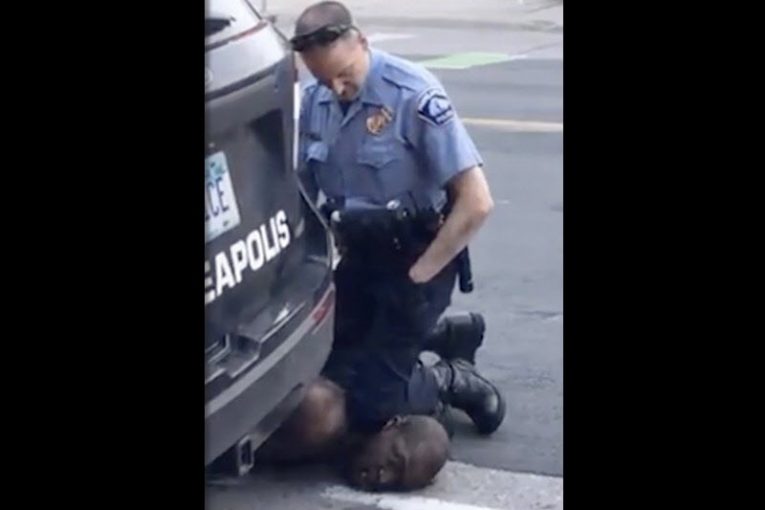

By Natasha Feuerstein and Jose Medina
MINNEAPOLIS, MN – Despite George Floyd suffocating to death on a city street with ex-cop Derek Chauvin’s knee choking the life out of him, a paramedic who arrived at the scene testified Thursday on Day 4 of Chauvin’s murder trial that his ambulance had been told only that there was a non-serious “mouth injury.”
Seth Bravander, a practicing paramedic since 2013, testified that on the day of George Floyd’s death, he initially responded to a “code 2” for “someone with a mouth injury.”
According to Bravander, a “code 2” refers to low-level criticality with no life-threatening indication. This code also signifies that the ambulance will engage in routine driving, meaning there are no lights or sirens.
About a minute and a half later, Bravander and his partner received a note that upgraded the code 2 to a code 3, meaning they should turn on the lights and sirens for an emergency response to the scene of the incident. They received no further information detailing what the code 3 was.
Chauvin’s defense attorney, Eric Nelson, asked Bravander to clarify the initial description about a mouth injury from dispatch.
“There was a description of a mouth injury, and that he may be intoxicated?” Nelson prompted.
Bravander told Nelson that there was a note about substance abuse of some kind, and that it read “Floyd was on top of a car.” He was not too sure about the exact details of the note other than  this.
this.
Upon the ambulance’s arrival, Bravander testified that he saw multiple officers on the side of the road “with our patient lying on the ground next to a squad car.”
When Nelson asked if it is commonplace for police officers to arrive on scene first to “deal with some dangerous situation,” Bravander replied that this was correct, depending on the type of call.
“Is it because when people are revived or resuscitated from an overdose, those people can become violent or aggressive?” Nelson asked.
“It can happen,” Bravander replied.
Bravander said he could not tell what condition Floyd was in since multiple officers were on top of him. Bravander assumed there was potentially some ongoing struggle occurring since the officers were still on top of Floyd.
As his partner approached Floyd and took his pulse and checked his pupils, Bravander stood a short distance away at the back of the ambulance and waited for instruction from his partner.
When the prosecution asked if Floyd was struggling or violent in any way at this point, Bravander said he was not.
“Did it appear he was dead already when you got there?” the prosecution asked. And, Bravander said from his position he could not see any breathing, movement, or signs of struggle, and Floyd was unresponsive so far as he could see.
As his partner returned to the ambulance, Bravander asked, “Is he in cardiac arrest?” to which his partner replied, “I think so.”
The prosecution asked Bravander to explain what it means to be in cardiac arrest to the jury. “It means someone’s heart has stopped. This is an emergency,” Bravander clarified.
When asked if ketamine is given to people who are alive and struggling, Bravander replied that this is sometimes given for “profound agitation.” Bravander further confirmed that you do not give ketamine to someone who is dead, in cardiac arrest, or unresponsive.
When asked what Floyd’s pupils looked like, Bravander said he could not recall, and would only be guessing from the report given to him by his partner.
After determining that Floyd was likely in cardiac arrest, Bravander and his partner decided to place Floyd into the ambulance where they would have access to the equipment needed for resuscitating a patient.
In video footage from one of the officer’s body cams, Bravander’s partner can be seen checking Floyd’s pulse as Officer Chauvin makes no movement to remove his knee from Floyd’s neck.
Bravander and his partner both come into view moments later with a stretcher. Bravander is seen making a hand gesture at Chauvin.
When asked what he was attempting to do with his hand gesture, Bravander stated that he was “telling the officer to move.” After his gesture, Chauvin is seen removing his knee from Floyd’s neck and making room for the stretcher.
Bravander is also seen via video footage holding Floyd’s head as they moved him onto the stretcher. He explained that he was trying to protect his head from “slamming onto the concrete” because “he was limp and was not responsive and not holding his head up.”
Bravander and his partner decided to drive the ambulance a couple blocks away from the Cup Foods since, in his mind, he wanted to “get away from [the crowd], and dealing with cardiac arrest requires a lot of effort and focus in a controlled space.”
One of the officers from the scene joined the two paramedics and Floyd in the ambulance to help with breathing compressions until EMTs from the fire department arrived to assist.
Once Bravander parked the ambulance again, he joined his partner and the officer in the back. At this point, he said the cardiac monitor was showing “asystole,” meaning that there is essentially no activity in the heart. Floyd’s condition had not improved.
A series of photographs was then presented to the court. Each photograph was taken from the body cam footage of the officer inside the ambulance. They showed Floyd lying on the stretcher, the two paramedics working on Floyd, and the officer holding the stretcher.
Bravander explained the actions they took to resuscitate Floyd, with different stages of this process shown in the photographs.
Summarizing, Bravander explained that according to his training there is a standard set of guidelines to follow when attempting to resuscitate a patient. Generally, the steps are to perform chest compressions, breathe for the patient, and administer medications.
When prompted about standard medications to use, Bravander further explained that it is standard to administer epinephrine to cardiac arrest patients in order to restart their heart.
It is also standard practice to give sodium bicarbonate to combat acidosis, or low pH. This is something Bravander learned during his training that is crucial to combat.
Once the fire department arrived to assist, Bravander said Floyd’s condition was still unchanged. The officer who was inside the ambulance left at this point.
After they finished following the standard guidelines for resuscitation, Bravander, his partner, and the EMTs transported Floyd to the hospital. Floyd’s overall condition did not appear to change upon arrival. He still had no pulse.
Over the course of Bravander’s interaction with Floyd, he testified that he saw no positive change in his condition.
The final witness of the day was retired police officer David Pleoger, who was Chauvin’s supervisor at the time of the incident. He recalled that he was working the evening shift as a patrol sergeant when he received a call from a concerned dispatcher.
A recording of the call was then heard by the court where the dispatcher could be heard inquiring about the police officers that she saw through a surveillance camera, pinning Floyd to the ground.
With a troubled tone, the dispatcher told Pleoger “all of them sat on this man, I don’t know if they needed to or not, they haven’t told me anything yet,” and she added “we don’t ever get to see it so we’re just like ‘oh uh well, that looks a little different.’ “
According to Pleoger, he had never received a call from a dispatcher like this before. He then called Chauvin to ask about the incident and was told that he had held somebody down but did not mention that he had put his knee on Floyd’s neck nor for how long.
Pleoger then stated to the court that he then proceeded with a use of force review, after learning of the incident, and sent it to internal affairs upon completion. He mentioned that he had reviewed body-worn camera footage of the incident.
Prosecutor Steve Schleicher then asked Pleoger what his opinion was, based on what he had seen from the footage, on when the restraint on Floyd should have ended.
Pleoger answered, “When Mr. Floyd was no longer offering any resistance to the officer they could’ve ended the restraint.”
He was then asked questions, by both the prosecution and defense, about the critical thinking model used by police when evaluating their use of force during any situation.
Taking into consideration Floyd’s unconscious state when he was knelt on by Chauvin, Schleicher asked “would it be reasonable in a critical thinking model to take in the subject’s medical condition to reset and reevaluate what they are doing?”
To that Pleoger responded with a yes.
Following Schleicher’s question, Nelson asked Pleoger if “dealing with people who are upset with you or volatile towards you” would also inform officers on whether or not to continue using force.
Again, Pleoger responded with a yes.
Before the court could adjourn, Schleicher then asked him if “people telling the officer that the person was in need of medical assistance might be important to consider” when using the critical thinking model.
Looking a bit tired after the back and forth questioning, Pleoger blankly said, “Sure.”
The jury was then dismissed with trial resuming Friday.
 Natasha Feuerstein is a senior at UC Davis majoring in Political Science and minoring in Global Disease Biology. She is originally from Camden, Delaware.
Natasha Feuerstein is a senior at UC Davis majoring in Political Science and minoring in Global Disease Biology. She is originally from Camden, Delaware.
Jose graduated from UC Davis with a BA in Political Science and has interned for the California State Legislature. He is from Rocklin, CA.
To sign up for our new newsletter – Everyday Injustice – https://tinyurl.com/yyultcf9
Support our work – to become a sustaining at $5 – $10- $25 per month hit the link:
This is powerful stuff: